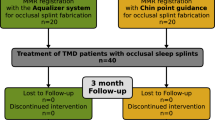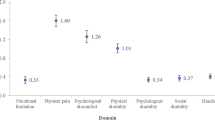Abstract
Design Prospective cohort study of 402 randomly-selected individuals aged 7, 11 and 15 years at baseline. A total of 320 completed a questionnaire after 20 years of which 100 patients, who were aged 15 at initial examination, were re-examined. Orthodontic treatment in the oldest age group was scrutinised by individual case records.
Outcome measure The questionnaire dealt with the presence of symptoms such as headaches, frequent stress or depression, previous trauma to the face, experience of temporomandibular disorders (TMD) during the 20 years of observation and current demand for TMD treatment. The clinical examination was conducted to measure any TMD signs and symptoms including limitation to range of movement, temporomandibular joint sounds and pain. Tooth wear was recorded on a five-point scale where 1 indicated no wear and 5 indicated wear of more than one-third of the clinical crown.
Results One hundred and two patients had received orthodontic treatment, 192 no orthodontic treatment and 26 did not know. Correlations between signs and symptoms of TMD and different malocclusions were weak. Lateral forced bite and unilateral crossbite were correlated with TMD signs and symptoms at the 10- and 20-year follow-ups (r2=0.38, P<0.05 and r2=0.34, P<0.01, respectively). Subjects who had malocclusion over a long period of time tended to report more symptoms of TMD and to show a higher dysfunction index, compared with subjects with no malocclusion at all.
Conclusions There were no statistically-significant differences in the prevalence of TMD signs and symptoms between subjects with or without previous experience of orthodontic treatment.
Similar content being viewed by others
Commentary
The issue of whether orthodontic treatment can cause, prevent or cure TMD has been debated for a long time and this research team have, over the years, contributed greatly to our knowledge of the subject.
This long-term cohort study, following individuals with or without a malocclusion who had either had or not had orthodontic treatment, is the most appropriate method to answer the question of whether the need for orthodontic treatment has any consequences for the long-term development of signs and symptoms of TMD. It is a 20-year follow-up of a cohort of 402 adults who were initially examined when they were 7, 11 or 15 years of age. The research team traced 378 (94%) of the initial cohort. All of the traced individuals were sent a questionnaire and members of the oldest cohort were invited to attend a clinical examination. The response rates for the questionnaire and clinical examination were 85 and 81% respectively.
The study found that 102 (32%) of the individuals who responded had received orthodontic treatment and that there were no statistically significant differences in the prevalence of signs and symptoms of TMD between those individuals who had/had not received orthodontic treatment. These results support the findings of other studies that suggest that people who have received orthodontic treatment are not at an increased risk of developing TMD later in life.1, 2
With respect to individuals with/without a malocclusion, there were few statistical correlations suggesting an association with signs or symptoms of TMD. A lateral displacement on closing and/or unilateral crossbite, however, were consistently associated with TMD. Again, this supports the findings of other studies3, 4 suggesting that the association of different malocclusions with TMD is nonexistent or weak, except in cases with a displacement on closing and/or unilateral crossbite.
I thought that the study had been conducted very well and it had an excellent follow-up rate which gives considerable weight to the findings. It highlights the benefit of a well-integrated healthcare service in being able to follow a cohort of patients over 20 years to provide good evidence on the long-term effects of a disease, in this case malocclusion, and treatment intervention.
Practice point
-
This paper adds weight to the evidence that orthodontic treatment does not predispose patients to TMD later in life and that most malocclusions, with the exception of lateral displacements on closing and/or unilateral crossbite, are not associated with the development of TMD.
References
Pilley JR, Mohlin B, Shaw WC, Kingdon A . A survey of craniomandibular disorders in 500 19-year-olds. Eur J Orthod 1997; 19:57–70.
Lagerstrom L, Egermark I, Carlsson GE . Signs and symptoms of temporomandibular disorders in 19-year-old individuals who have undergone orthodontic treatment. Swed Dent J 1998; 22:177–186.
Mohlin B, Thilander B . The importance of the relationship between malocclusion and mandibular dysfunction and some clinical applications in adults. Eur J Orthod 1984; 6:192–204.
Thilander B, Rubio G, Pena L, de Mayorga C . Prevalence of temporomandibular dysfunction and its association with malocclusion in children and adolescents: an epidemiologic study related to specified stages of dental development. Angle Orthod 2002; 72:146–154.
Author information
Authors and Affiliations
Additional information
Address of correspondence: Dr Inger Egerman, Department of Orthodontics, Göteborg University, Box 450, Göteborg SE-405 30, Sweden.
Egermark I, Magnusson T, Carlsson GE. A 20-year follow-up of signs and symptoms of temporomandibular disorders and malocclusions in subjects with and without orthodontic treatment in childhood. Angle Orthod 2003; 73:109–115
Rights and permissions
About this article
Cite this article
Harrison, J. Evidence suggests that orthodontic treatment as a child is not related to later TMD. Evid Based Dent 4, 82 (2003). https://doi.org/10.1038/sj.ebd.6400224
Published:
Issue Date:
DOI: https://doi.org/10.1038/sj.ebd.6400224



